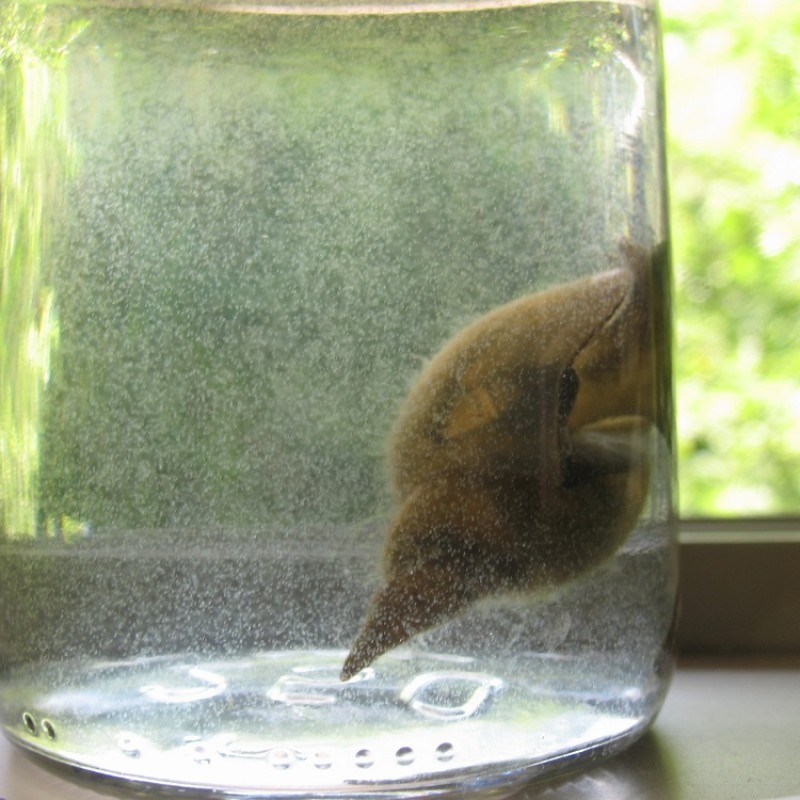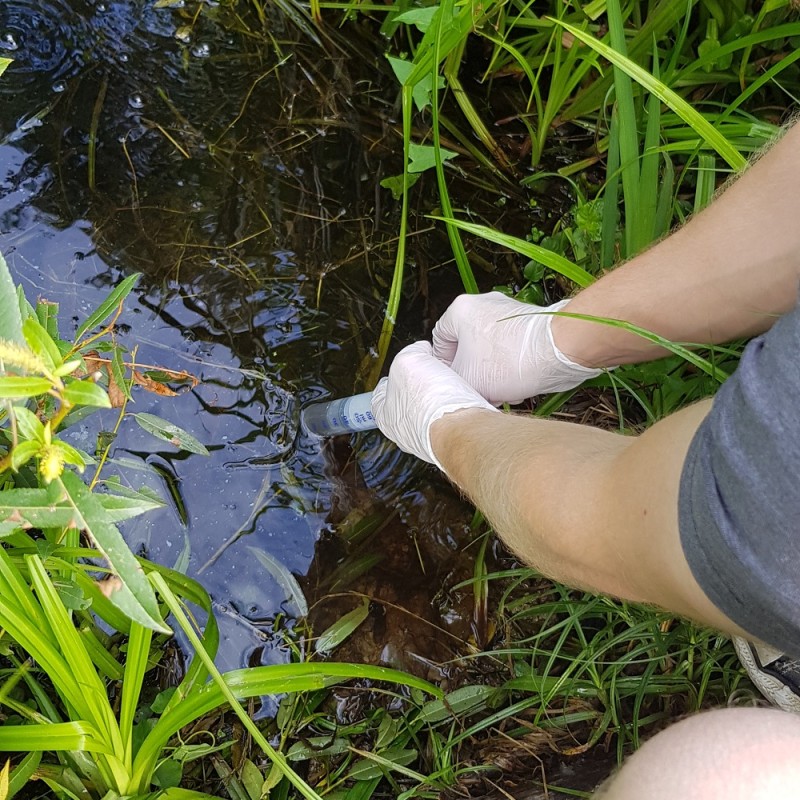Trematodes: NHM research team discovers two new species
25. March 2022
The diversity of trematodes,
minuscule parasitic worms, is being researched at the Natural History Museum in Vienna. In the context of a research project,
two species previously unknown in Austria were discovered that can cause a skin rash in humans, the so-called swimmer’s itch.
The species were identified by means of DNA analysis within the framework of the ABOL (Austrian Barcode of Life) initiative.
Trematodes are not exactly popular. Swimming in stagnant waters in the summer can lead to unpleasant skin rashes caused by
the larvae of certain trematode species. During longer periods of heat and water temperatures between 26 and 28 degrees centigrade,
cases of cercarial dermatitis, or swimmer’s itch, are observed frequently, or even epidemically, especially if the body of
water is inhabited by animals such as water snails and ducks. The trematode species Trichobilharzia franki and Trichobilharzia
physellae, which were recently detected for the first time in Austria, also cause such inflammatory skin reactions in
humans.
The research project particularly targeted avian bilharzia – trematodes that use water fowl as hosts. Ending up in the water via the faeces of infected birds, their eggs release larvae which penetrate and reproduce in water snails. After further developmental steps within the snails, another generation of larvae – so-called cercariae – are released. They infect water birds by burrowing into their skin by means of escape glands and colonise a variety of organs.
The cercariae use chemical sensors to find their hosts. These sensors are so unspecific, however, that they can also inadvertently lead to an infestation of false hosts, such as humans. In humans the parasites do not develop further but die off. If there are multiple infestations, the immune defence of the unlucky human host often causes an allergic reaction that causes dermatitis.
This dermatitis can befall swimmers in near-natural waters, but also people whose jobs bring them in contact with bodies of water. It can cause a severe rash that lasts up to two weeks. While annoying, the rash is basically harmless, but scratching can lead to secondary infections and complications. Swimmer’s itch (or cercarial dermatitis) is therefore a recurring issue, especially in regions with natural waters used by tourists.
Trichobilharzia franki and Trichobilharzia physellae
The scientists of the NHM Vienna took samples from different bodies of water, from lakes to swimming ponds and small biotopes. They collected live water snails and examined them for the presence of trematode larvae. In addition to two already known parasite species, Trichobilharzia franki was detected for the first time in Austria two years ago, a species that was already known to occur in other European countries.
Recently, the team made a far more surprising find: the first European discovery of Trichobilharzia physellae, previously known from North America. It was found in a small Upper Austrian swimming lake, in a snail species that also originally came from North America. This snail – going by the name of acute bladder snail or Physella acuta – has been known in Europe for about 200 years, and for about 75 years in Austria. An invasive species, it has spread worldwide. Since the cercariae detected in the project are genetically very similar to their North American conspecifics, the researchers suspect that this is a recent introduction, which may have occurred via freshly imported and already infected snails – for instance in the context of the international trade in aquarium plants or via infested ducks crossing the Atlantic.
“The first detection of two new species of trematodes in Austria within only two years suggests that not all species by far of this little-researched group have been identified yet,” says Christoph Hörweg, parasitologist and head of the 3rd Zoological Department at the NHM Vienna. “The establishment of species evidence via DNA provides completely new insights,” adds Dr. Nikola Szucsich, principal investigator and ABOL manager.
The current study also served to develop an innovative method for the genetic detection of the parasites in water samples. The detection of cercarial dermatitis via environmental DNA (eDNA) makes it possible to dispense with time-consuming steps such as collecting and holding the snails until the cercariae are determined under the microscope, which is not an easy thing to do. However, the current data situation on trematodes in Austria (and many other countries) is still insufficient. Therefore, it is important to continue recording biodiversity within the context of projects such as the Austrian Barcode of Life (ABOL) initiative coordinated by the NHM Vienna.
“Cercariae only occur in near-natural lakes. They need water snails that like to live in the reeds and at least occasionally ducks. The cercariae are usually washed into shallow shoreside waters by the wind,” says NHM Vienna Director General and Scientific Director Dr Katrin Vohland. She recommends: “When swimming, avoid shallow water if possible. If you are a swimmer, go to the deep! Also, upon coming out of the water, take off your bathing suit immediately and firmly rub your skin dry. This reduces the number of the little beasties on your skin. “
The research project was commissioned by the Water Quality Supervision Unit of the Upper Austrian Provincial Government and supported by the Friends of the Natural History Museum.
Publications:
Reier, S., Haring, E., Billinger, F., Blatterer, H., Duda, M., Gorofsky, C., Grasser, H.-P., Heinisch, W., Hörweg, C., Kruckenhauser, L., Szucsich, N. U., Wanka, A., & Sattmann, H. (2020). First confirmed record of Trichobilharzia franki Müller & Kimmig, 1994, from Radix auricularia (Linnaeus, 1758) for Austria. Parasitology Research, 119(12), 4135–4141. https://doi.org/10.1007/s00436-020-06938-3
Helmer, N., Blatterer, H., Hörweg, C., Reier, S., Sattmann, H., Schindelar, J., Szucsich, N. U., & Haring, E. (2021). First Record of Trichobilharzia physellae (Talbot, 1936) in Europe, a Possible Causative Agent of Cercarial Dermatitis. Pathogens, 10(11), 1473. https://doi.org/10.3390/pathogens10111473
Link to the ABOL website:
www.abol.ac.at
The research project particularly targeted avian bilharzia – trematodes that use water fowl as hosts. Ending up in the water via the faeces of infected birds, their eggs release larvae which penetrate and reproduce in water snails. After further developmental steps within the snails, another generation of larvae – so-called cercariae – are released. They infect water birds by burrowing into their skin by means of escape glands and colonise a variety of organs.
The cercariae use chemical sensors to find their hosts. These sensors are so unspecific, however, that they can also inadvertently lead to an infestation of false hosts, such as humans. In humans the parasites do not develop further but die off. If there are multiple infestations, the immune defence of the unlucky human host often causes an allergic reaction that causes dermatitis.
This dermatitis can befall swimmers in near-natural waters, but also people whose jobs bring them in contact with bodies of water. It can cause a severe rash that lasts up to two weeks. While annoying, the rash is basically harmless, but scratching can lead to secondary infections and complications. Swimmer’s itch (or cercarial dermatitis) is therefore a recurring issue, especially in regions with natural waters used by tourists.
Trichobilharzia franki and Trichobilharzia physellae
The scientists of the NHM Vienna took samples from different bodies of water, from lakes to swimming ponds and small biotopes. They collected live water snails and examined them for the presence of trematode larvae. In addition to two already known parasite species, Trichobilharzia franki was detected for the first time in Austria two years ago, a species that was already known to occur in other European countries.
Recently, the team made a far more surprising find: the first European discovery of Trichobilharzia physellae, previously known from North America. It was found in a small Upper Austrian swimming lake, in a snail species that also originally came from North America. This snail – going by the name of acute bladder snail or Physella acuta – has been known in Europe for about 200 years, and for about 75 years in Austria. An invasive species, it has spread worldwide. Since the cercariae detected in the project are genetically very similar to their North American conspecifics, the researchers suspect that this is a recent introduction, which may have occurred via freshly imported and already infected snails – for instance in the context of the international trade in aquarium plants or via infested ducks crossing the Atlantic.
“The first detection of two new species of trematodes in Austria within only two years suggests that not all species by far of this little-researched group have been identified yet,” says Christoph Hörweg, parasitologist and head of the 3rd Zoological Department at the NHM Vienna. “The establishment of species evidence via DNA provides completely new insights,” adds Dr. Nikola Szucsich, principal investigator and ABOL manager.
The current study also served to develop an innovative method for the genetic detection of the parasites in water samples. The detection of cercarial dermatitis via environmental DNA (eDNA) makes it possible to dispense with time-consuming steps such as collecting and holding the snails until the cercariae are determined under the microscope, which is not an easy thing to do. However, the current data situation on trematodes in Austria (and many other countries) is still insufficient. Therefore, it is important to continue recording biodiversity within the context of projects such as the Austrian Barcode of Life (ABOL) initiative coordinated by the NHM Vienna.
“Cercariae only occur in near-natural lakes. They need water snails that like to live in the reeds and at least occasionally ducks. The cercariae are usually washed into shallow shoreside waters by the wind,” says NHM Vienna Director General and Scientific Director Dr Katrin Vohland. She recommends: “When swimming, avoid shallow water if possible. If you are a swimmer, go to the deep! Also, upon coming out of the water, take off your bathing suit immediately and firmly rub your skin dry. This reduces the number of the little beasties on your skin. “
The research project was commissioned by the Water Quality Supervision Unit of the Upper Austrian Provincial Government and supported by the Friends of the Natural History Museum.
Publications:
Reier, S., Haring, E., Billinger, F., Blatterer, H., Duda, M., Gorofsky, C., Grasser, H.-P., Heinisch, W., Hörweg, C., Kruckenhauser, L., Szucsich, N. U., Wanka, A., & Sattmann, H. (2020). First confirmed record of Trichobilharzia franki Müller & Kimmig, 1994, from Radix auricularia (Linnaeus, 1758) for Austria. Parasitology Research, 119(12), 4135–4141. https://doi.org/10.1007/s00436-020-06938-3
Helmer, N., Blatterer, H., Hörweg, C., Reier, S., Sattmann, H., Schindelar, J., Szucsich, N. U., & Haring, E. (2021). First Record of Trichobilharzia physellae (Talbot, 1936) in Europe, a Possible Causative Agent of Cercarial Dermatitis. Pathogens, 10(11), 1473. https://doi.org/10.3390/pathogens10111473
Link to the ABOL website:
www.abol.ac.at




